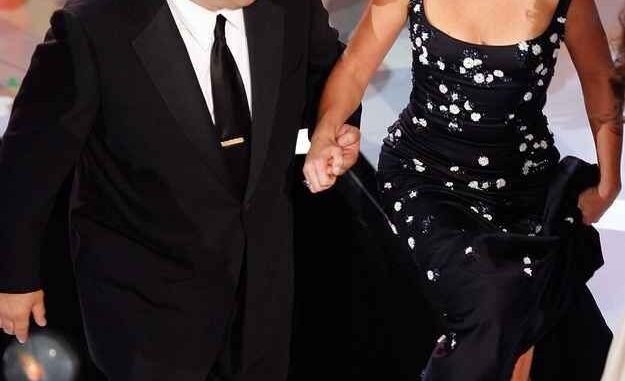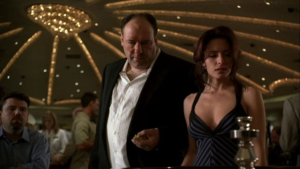
Introduction: The Unspoken Rule of the Sopranos
When you think of The Sopranos, you probably picture James Gandolfini’s unforgettable portrayal of Tony Soprano—a tough, conflicted mob boss navigating the ups and downs of family life and organized crime. What many don’t know is that Gandolfini’s performance wasn’t just about acting skill. It was influenced by some real-life advice from actual members of the New Jersey mafia.
There’s one crucial thing Gandolfini was explicitly told never to do while playing the iconic role of Tony Soprano—something so simple yet incredibly significant. This piece of advice came straight from the mouths of mobsters, and surprisingly, Gandolfini listened. Let’s dive into the story behind the warning, how it shaped The Sopranos’ realism, and why Gandolfini chose to comply.
The Mob’s Warning to James Gandolfini
Before Gandolfini took on the role of Tony Soprano, he was given a bit of crucial advice from some real-life mobsters from New Jersey. This advice was centered around how a don—someone who runs an organized crime family—should behave. In particular, there was one thing the mobsters specifically warned him never to do on the show.

“Dons Don’t Wear That”—The Warning
James Gandolfini, in his portrayal of Tony Soprano, was keen on bringing authenticity to the role. He wanted to make sure that his portrayal of the mafia boss was as realistic as possible. In fact, he was advised by a group of New Jersey mobsters never to wear a certain item that they felt would break character for a true don. What was that item? A leather jacket.
Why, you ask? Leather jackets, according to the mobsters, weren’t something that a real mafia boss would ever wear. In their eyes, it was a sign of aggression and something more associated with street thugs than high-ranking mafia dons. Mobsters at the top of their game, like Tony Soprano, would dress with sophistication, style, and a touch of authority—not in a way that would draw unnecessary attention or look too “flashy.”
How Gandolfini Complied with the Advice
Gandolfini, a method actor who always strived for authenticity, took the advice of his real-life mob contacts seriously. Instead of going for the usual leather jackets that many might associate with tough-guy characters, he opted for more refined clothing choices that matched the character’s power and status.
Dressing the Part of a Mafia Boss
Instead of leather, Gandolfini’s Tony Soprano often wore high-end suits, button-up shirts, and tasteful sweaters. His wardrobe reflected his character’s personality: a man who is both powerful and restrained, a leader who commands respect without needing to scream for it through flashy outfits.

By choosing to align his wardrobe with what a mob boss would actually wear, Gandolfini managed to infuse a level of authenticity into the character of Tony Soprano that many viewers may not even notice—but it was there, subtly shaping the tone of the show.
Why Real Mobsters Influenced Tony’s Wardrobe Choices
The decision to avoid leather jackets wasn’t just about fashion—it was about staying true to the life of a real mafia boss. The mobsters who advised Gandolfini weren’t just looking at the aesthetics of Tony’s wardrobe—they were considering the psychology behind it. A don doesn’t need to show off wealth with his clothing. He commands respect through his presence and the way he carries himself, not by wearing flashy clothes.
Understanding the Psychology of the Mafia Boss
In the mafia, image is everything. But it’s not about being loud or attention-grabbing. A don’s power is derived from the fear and respect he instills in others. His wardrobe choices reflect this quiet authority. By not wearing leather jackets or other loud garments, Gandolfini was able to portray Tony Soprano as a man who doesn’t need to shout about his power; instead, his power speaks for itself.
The Importance of Authenticity in The Sopranos
The Sopranos wasn’t just a television show—it was a masterclass in blending reality with fiction. From the way the characters spoke to the clothes they wore, every detail was meticulously crafted to ensure the show felt as authentic as possible. Gandolfini’s attention to wardrobe detail played a key role in making Tony Soprano one of the most believable mafia bosses in TV history.
The Show’s Commitment to Realism
The Sopranos wasn’t just about the glitz and glamor of organized crime—it was about showing the gritty, everyday reality of life within a mafia family. By avoiding overtly flashy clothing and emphasizing a more understated style, the show communicated the idea that the real mafia isn’t about looking like a gangster from the movies—it’s about maintaining power, control, and loyalty.
Gandolfini’s Natural Fit for the Role of Tony Soprano
Gandolfini’s portrayal of Tony Soprano went far beyond wardrobe choices. He embodied the character in a way that felt incredibly real. His gruff demeanor, his emotional complexity, and his ability to balance the roughness of a mafia boss with the vulnerability of a man struggling with his personal demons made him the perfect fit for the role. The advice about clothing simply helped him maintain a consistent, authentic character throughout the show.
Tony Soprano’s Legacy and the Influence of Real Mobsters
The influence of real mobsters on the portrayal of Tony Soprano extended far beyond clothing choices. The authenticity of Gandolfini’s performance was built on the advice of those who had lived the life of organized crime. By listening to the mobsters’ warning and making subtle changes to his wardrobe, Gandolfini ensured that Tony Soprano would become a character viewers could believe in—not just because of his actions but because of the way he presented himself.
The Fine Line Between Fiction and Reality
While The Sopranos was a fictional story, the characters within it were often based on the real experiences and attitudes of those involved in the mafia. By consulting real mobsters, the show ensured that its portrayal of mafia life was grounded in reality, making it stand out from other mob dramas that leaned more heavily on stereotypes.
The Enduring Popularity of The Sopranos’ Realism
The realism that The Sopranos maintained throughout its run helped it resonate with audiences and critics alike. It wasn’t just the gritty mob storylines or the compelling characters that made the show so great—it was the attention to detail that made it feel like a true-to-life portrayal of the mafia world. James Gandolfini’s decision to comply with the wardrobe advice was just one example of how the show strived for realism, and it paid off in spades.
Conclusion: The Power of Subtlety in The Sopranos
In the world of The Sopranos, power wasn’t about flashy clothes or overt aggression. It was about command, control, and a certain understated elegance. By taking the advice of real mobsters and avoiding leather jackets, James Gandolfini ensured that his portrayal of Tony Soprano was as authentic and believable as possible. His decision to listen to this advice and dress the part helped shape one of the most iconic characters in television history.
As we look back on The Sopranos, it’s clear that the show’s success lies not just in its gripping storylines but in its attention to detail—down to the smallest elements, like Tony’s wardrobe. So, the next time you watch the show, remember that every little choice made by Gandolfini and the creators contributed to the realism that made The Sopranos stand out as one of the greatest TV dramas of all time.
FAQs
- Why did Gandolfini choose to listen to the mobsters’ wardrobe advice? Gandolfini wanted to ensure his portrayal of Tony Soprano was authentic, and the real mobsters’ advice about dressing like a true don helped him maintain the character’s believability.
- What was the one thing Gandolfini was warned not to wear on The Sopranos? Gandolfini was told never to wear a leather jacket, as it was seen as too aggressive and not something a high-ranking mafia boss would wear.
- How did Tony Soprano’s wardrobe contribute to his character? Tony’s understated wardrobe, including suits and sweaters, reflected his quiet authority and power, reinforcing his status as a respected don.
- How did real mobsters influence the portrayal of Tony Soprano? Real-life mob
